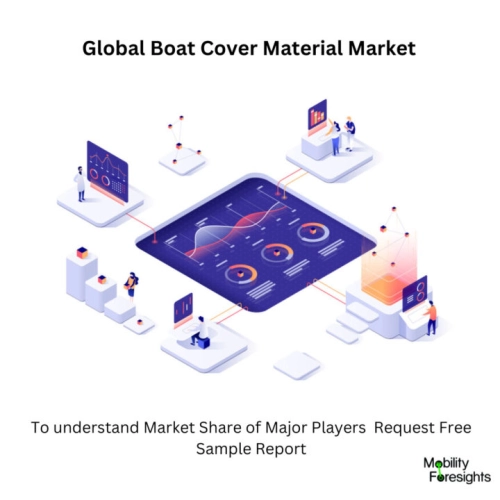
- Get in Touch with Us

Last Updated: Apr 25, 2025 | Study Period: 2024-2030
Boat covers are protective covers intended to protect boats from various environmental elements when they are not in use. The term "boat cover material" refers to the fabric or material used to construct boat covers.
Materials for boat covers are specifically designed to offer strength, water resistance, UV protection, and other important properties to safeguard the outside of the boat.
Typical components for boat coverings include:
Polyester: Due to their strength, abrasion resistance, and UV resistance, polyester materials are preferred for boat coverings. To increase their water resistance, they are frequently given coatings or finishes.
Sunbrella and other acrylic textiles are frequently used for boat coverings. They are renowned for their great breathability, water resistance, and fade resistance. Additionally, acrylic fabrics provide exceptional resistance against UV radiation and mildew.
Nylon: Fabrics made of nylon are robust, lightweight, and have high abrasion resistance. Although they are not as frequently used as polyester or acrylic for boat covers, they can be effective in some situations.
Vinyl: Vinyl textiles, often known as marine vinyl or PVC, offer excellent moisture protection and are very water-resistant. They are a well-liked option for boat coverings because they are simple to maintain and clean.
High-density polyethylene (HDPE) or polyethylene tarpaulins are two examples of polyethylene materials that are strong, lightweight, and frequently used for temporary or less expensive boat covers.
Although there are variations and mixtures available on the market, these are some of the materials that are frequently used for boat covers. The material selected will depend on the size of the boat, the environment, the planned use, and individual preferences for performance, durability, and aesthetics.

The Global Boat Cover Material market accounted for $XX Billion in 2023 and is anticipated to reach $XX Billion by 2030, registering a CAGR of XX% from 2024 to 2030.
Every boat needs to be covered if you want to keep it safe and in top shape. The ultimate multipurpose item is the brand new MSC Heavy Duty Waterproof Boat Cover. It's made of 600-denier marine-grade polyester canvas, which is praised for its durability in all weather conditions.
The cover's resistance to water is increased with a double polyurethane coating. It won't shrink or stretch even after extended exposure to the outdoors and is UV and mildew resistant. Thanks to the provided adjustable straps and the elastic cord sewed into the bottom of the hem, it can be used for mooring, storage, and trailering.
These features enable a fit that is nearly personalised. The straps feature useful quick-release buckles as well. Choose from six types, including V-hull, runabout, tri-hull, and pro-style bass boat forms, that are made to match a variety of boat lengths and beam widths. Similar to how neutral grey is meant to go with any paint or decals.
Keep your boathouse in tip-top shape by storing the cover when it's not in use in the drawstring canvas bag that comes with it. For additional peace of mind, the cover comes with a limited three-year warranty.
| Sl no | Topic |
| 1 | Market Segmentation |
| 2 | Scope of the report |
| 3 | Abbreviations |
| 4 | Research Methodology |
| 5 | Executive Summary |
| 6 | Introduction |
| 7 | Insights from Industry stakeholders |
| 8 | Cost breakdown of Product by sub-components and average profit margin |
| 9 | Disruptive innovation in the Industry |
| 10 | Technology trends in the Industry |
| 11 | Consumer trends in the industry |
| 12 | Recent Production Milestones |
| 13 | Component Manufacturing in US, EU and China |
| 14 | COVID-19 impact on overall market |
| 15 | COVID-19 impact on Production of components |
| 16 | COVID-19 impact on Point of sale |
| 17 | Market Segmentation, Dynamics and Forecast by Geography, 2024-2030 |
| 18 | Market Segmentation, Dynamics and Forecast by Product Type, 2024-2030 |
| 19 | Market Segmentation, Dynamics and Forecast by Application, 2024-2030 |
| 20 | Market Segmentation, Dynamics and Forecast by End use, 2024-2030 |
| 21 | Product installation rate by OEM, 2023 |
| 22 | Incline/Decline in Average B-2-B selling price in past 5 years |
| 23 | Competition from substitute products |
| 24 | Gross margin and average profitability of suppliers |
| 25 | New product development in past 12 months |
| 26 | M&A in past 12 months |
| 27 | Growth strategy of leading players |
| 28 | Market share of vendors, 2023 |
| 29 | Company Profiles |
| 30 | Unmet needs and opportunity for new suppliers |
| 31 | Conclusion |
| 32 | Appendix |